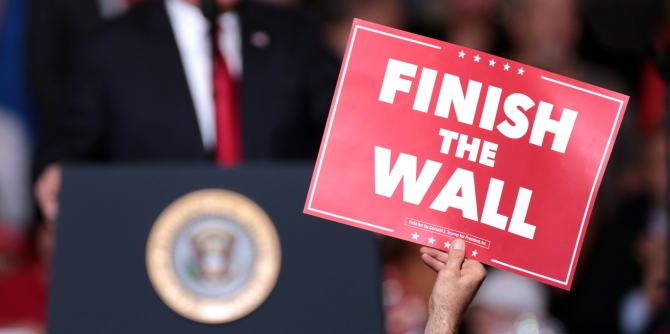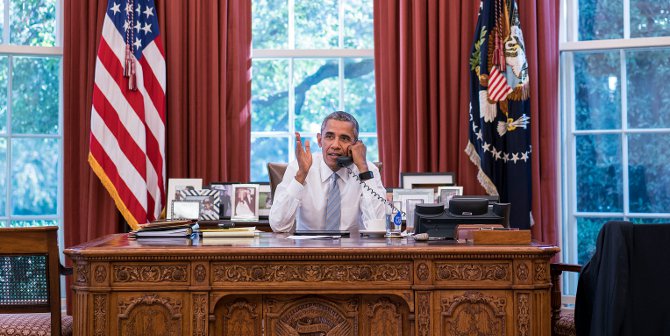 At the end of last week, President Trump declared a national emergency to tackle the spread of the coronavirus in the US. Joshua Kennedy looks at what this emergency declaration will mean for confronting the crisis: a reduction in regulatory requirements and the freeing of funds. Despite the declaration, he writes, most of the implementation and enforcement of coronavirus-related policies will be the responsibility of state and local governments, with the federal government coordinating many of these efforts.
At the end of last week, President Trump declared a national emergency to tackle the spread of the coronavirus in the US. Joshua Kennedy looks at what this emergency declaration will mean for confronting the crisis: a reduction in regulatory requirements and the freeing of funds. Despite the declaration, he writes, most of the implementation and enforcement of coronavirus-related policies will be the responsibility of state and local governments, with the federal government coordinating many of these efforts.
What is the US federal government’s emergency power and what are its effects? As the coronavirus continues its worldwide spread, graduating to formal classification by the World Health Organization as a pandemic on March 11th, eyes in the United States turn out of necessity to the president, whose status as head of a vast administrative apparatus grants him considerable, but limited, authority to manage the growing crisis. On March 13th, 2020, President Trump formally issued a proclamation declaring a national emergency over the spread of the coronavirus. There are two laws at issue concerning the declaration: the National Emergencies Act and the Robert T. Stafford Disaster Relief and Emergency Assistance Act. The National Emergencies Act empowers the president to declare emergencies and exercise special powers pursuant to said emergency (said powers the president is exercising must be formally specified). The Robert T. Stafford Disaster Relief and Emergency Assistance Act, meanwhile, largely concerns the availability of federal funds to states and localities for disaster relief.
Under the authority of the National Emergencies Act, the proclamation itself explicitly authorizes the Secretary of the Department of Health and Human Services (HHS), Alex Azar, to exercise broad discretionary powers delegated by Section 1135 of the Social Security Act. This will allow Azar to potentially waive numerous regulatory requirements (for example, requirements dealing with licensing of healthcare personnel or payments made to such personnel outside of a patient’s network) in an effort to speed up responsiveness.
In a further letter to Acting Secretary Chad Wolf of the Department of Homeland Security, Secretaries Steven Mnuchin and Azar of the Departments of the Treasury and HHS respectively, and Administrator Pete Gaynor of the Federal Emergency Management Agency, Trump invoked certain powers under the Robert T. Stafford Disaster Relief and Emergency Assistance Act that will free up various governmental funds for ongoing efforts to fight the spread of the coronavirus. This letter also ordered Mnuchin and the Treasury Department “to provide relief from tax deadlines to Americans who have been adversely affected by the COVID-19 emergency” and empowered the Federal Emergency Management Agency (FEMA) to exercise an important coordinative function over the response. What do these actions mean from a practical perspective, and how effective is the government’s response likely to be?
In the main, emergency declarations allow for the federal government to provide more direct assistance to states working to contain the spread of the virus and to circumvent certain regulatory requirements. For practical purposes, much of the implementation and enforcement of policies relating to the spread of the coronavirus will be handled by state and local governments, which have broad police powers the federal government lacks. It is therefore incumbent upon the federal government to be prepared to assist these state efforts, and emergency declarations are means by which resources can be more readily mobilized.

“President Trump Holds a News Conference on the Coronavirus” by The White House is Public Domain.
How successful these efforts will be at stemming the tide is very much an open question. The federal government’s role at this point is a coordinator in many respects. Since so much of the enforcement of issues around the coronavirus, for example restaurant closures and potential quarantines, are constitutionally the responsibility of the state governments and their localities, the federal government has a duty to provide states with important federal resources to lessen the blow of the virus, particularly with respect to the potential damage that could be done to the capacity of the American healthcare system. Resources and reduced regulatory requirements that may make it easier for states to adjust to the realities of the pandemic are in this respect a positive development.
There is also something to be said for the symbolism around an emergency declaration. While emergencies do confer certain substantive powers on the president and the federal government, Americans are also hungry for moral leadership in times of crisis. There is a desire to know that officials at the highest levels are treating the problem with the seriousness it deserves, and in this respect the emergency declaration is an important signal. It is also one that is especially important given the mixed messages emanating at times from the White House in the preceding weeks.
An emergency declaration is also not necessarily a singular event. Under the National Emergencies Act, which, as mentioned, President Trump made reference to in his March 13th proclamation, presidents are required to identify the statutory powers they, or their subordinates, will be exercising in light of the emergency. The most recent proclamation concerned Secretary Azar’s powers under the Social Security Act, but there is no reason why President Trump could not issue additional proclamations, executive orders, or letters that expand the scope of the emergency and the powers being exercised. All that is required is that he make Congress aware which powers he will be using. The emergency expires either at the discretion of the president or by joint resolution of Congress (subject to a presidential veto).
This is a critical moment for the United States at all levels: federal, state, and local. The president, the Congress, the federal bureaucracy, and state and local governments are about to be tested in ways they have not experienced. The emergency declaration is an important step in preparing the country to meet the challenge it faces in the coming weeks and months, though its effectiveness will have to be demonstrated.
Please read our comments policy before commenting.
Note: This article gives the views of the author, and not the position of USAPP– American Politics and Policy, nor of the London School of Economics.
Shortened URL for this post: http://bit.ly/2x3lINO
About the author
 Joshua Kennedy – Georgia Southern University
Joshua Kennedy – Georgia Southern University
Joshua Kennedy is an Assistant Professor of Political Science at Georgia Southern University. His research interests principally focus on the American presidency, unilateral presidential power, and the federal bureaucracy.






